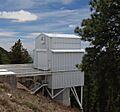Apache Point Observatory facts for kids
Quick facts for kids Apache Point Observatory |
|||||||||||
|---|---|---|---|---|---|---|---|---|---|---|---|

ARCSAT and SDSS telescope buildings at the Apache Point Observatory.
|
|||||||||||
| Organization | Astrophysical Research Consortium | ||||||||||
| Location | Sunspot, New Mexico | ||||||||||
|
Coordinates
|
32°46′49″N 105°49′13″W / 32.78028°N 105.82028°W
|
||||||||||
| Altitude | 2,788 meters (9,147 ft) | ||||||||||
| Weather | 65% clear nights | ||||||||||
| Established | 1985 | ||||||||||
|
|||||||||||
The Apache Point Observatory (APO) is a special place where scientists study the stars and space. It is an astronomical observatory located high in the Sacramento Mountains in Sunspot, New Mexico, USA. This observatory is about 18 miles (29 km) south of Cloudcroft.
New Mexico State University (NMSU) helps run the observatory. The Astrophysical Research Consortium (ARC) owns it. Only authorized people can go inside the telescope buildings.
Contents
History of Apache Point Observatory
The Astrophysical Research Consortium (ARC) was created in 1984. Their main goal was to build a large 3.5-meter telescope. Five universities first joined this group. These included New Mexico State University, the University of Washington, and Princeton University.
Over time, more groups joined the ARC. These new members included Johns Hopkins University and the University of Colorado. The money for the main telescopes comes from these groups. New Mexico State University pays for its own 1.0-meter telescope.
Telescopes at Apache Point
Apache Point Observatory has several powerful telescopes. Each one helps astronomers learn more about the universe. They use these telescopes to take pictures and study light from distant objects.
ARC 3.5-meter Telescope
The ARC 3.5-meter telescope is a type of telescope called a Ritchey-Chretien reflector. It uses mirrors to gather light from space. Building the telescope started in 1985. However, it took until 1994 for it to fully start working. This was because of problems making its main mirror.
This telescope has many tools to help scientists. These tools can take pictures and split light into different colors. This helps them understand what stars and galaxies are made of.
- The ARC echelle spectrometer (ARCES) takes detailed pictures of light.
- The Double Imaging Spectrometer (DIS) is used for general light studies.
- The Near Infrared Camera/Fabry–Pérot Spectrometer (NICFPS) looks at infrared light. This light is invisible to our eyes.
- The Seaver Prototype Imaging Camera (SPIcam) takes clear optical images.
- TripleSpec (Tspec) is another tool for studying infrared light.
The 3.5-meter telescope also helps with a special project. It is part of the Apache Point Observatory Lunar Laser-ranging Operation (APOLLO). This project uses a laser to measure the exact distance to the Moon. It can measure this distance with amazing accuracy. Scientists can even use the telescope from far away. They use a special computer program over the internet.
SDSS 2.5-meter Telescope
The SDSS 2.5-meter telescope is used for the Sloan Digital Sky Survey. This project maps large parts of the sky. The telescope started working in 2000. It is also a Ritchey-Chretien reflector telescope.
This telescope has a very wide view of the sky. This design helps it to survey huge areas quickly. It is housed under a special roof that rolls off when observations are happening.
NMSU 1.0-meter Telescope
The NMSU 1.0-meter telescope was finished in 1994. It is a Ritchey-Chretien reflector telescope. It uses a special camera to capture images of the sky. This camera provides a clear view of a specific area of space.
0.5-meter ARCSAT Telescope
The ARC Small Aperture Telescope (ARCSAT) is a smaller telescope. It used to be part of the Sloan Digital Sky Survey. It was built in 1991.
This telescope is now used for smaller research projects. It has a camera that is cooled to help it take better pictures.
Images for kids
See also
 In Spanish: Observatorio de Apache Point para niños
In Spanish: Observatorio de Apache Point para niños






